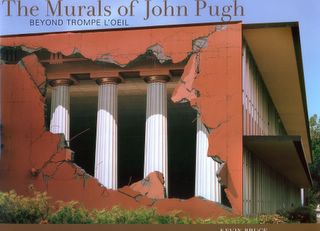
World-renowned muralist returns to Chico for book signing, reception
By DAN BARNETT
Author Kevin Bruce writes that he first met John Pugh in a Los Gatos pub in 1984. The two became fast friends, and now Bruce has expanded his Stanford University master's thesis on seven of Pugh's murals into a breathtaking study of 35 of Pugh's finest works. "The Murals of John Pugh: Beyond trompe l'oeil" ($35 in hardcover from Ten Speed Press) features stunning full-color spreads of Pugh's art along with telling close-ups of areas the eye might well miss.
The term "trompe l'oeil" means "trick of the eye," and it's applied to two-dimensional art that fools the eye into seeing a three-dimensional space. Though such techniques were practiced in ancient Greece, as Bruce notes in his historical overview, Pugh's real precursor was the Mexican muralist Diego Rivera, who in 1931 "produced a trompe l'oeil mural ... at the California School of Fine Arts" that saluted "the 'skyscraping' construction in the United States."
Pugh himself got his start at Chico State University majoring in art. In his senior year he received a commission "to create a mural on a wall of Taylor Hall, which housed, most appropriately, the Chico State Art Department." As Bruce writes, "Begun in the fall of 1980 and completed in the spring of 1981, this mural would receive international recognition and launch Pugh's career in a spectacular fashion." The mural was called "Academe" (acrylic on concrete, 24 feet by 36 feet).
Pugh and Bruce will launch the new book in Chico Friday with an illustrated talk in Ayres Hall 106 at 4 p.m. and a reception honoring them both at the Taylor Hall mural. The public is invited. (A news release notes that "Pugh was honored as the College of Humanities and Fine Arts' Distinguished Alum in 2003. He returned to Chico that summer and spent a week refurbishing the mural, much to the delight of Chicoans who visited him long into the hot summer nights as he repainted the wall.")
Bruce writes that "at Taylor Hall, Pugh's first step was to establish a site-specific conceptual scheme: 'I kept looking at the wall thinking of how to best reveal in a mural the meaning of the art building both architecturally and conceptually.' He decided that the best symbol to accomplish this dual statement would be to 'go all the way back to the original Doric-style Greek column. ... My intention was ... to tap into the concept of the Greek academe as the essence of our western educational system'."
Rather than simply paint a realistic-looking series of columns, Pugh was influenced by a dream to "break open" the wall on Taylor and, as Bruce puts it, "fill this fictive space with relevant narrative creations -- intended to engage the viewer on deeper levels."
It is this narrative element in Pugh's work that sets it apart from mere trickery. Since his Chico State experience Pugh has painted many public art pieces, murals for hospitals, parking garages and libraries that attract the mind as well as the eye. Some are controversial, like his 2005 piece, "Drain," in Bishop, which evoked strong emotions about the "water wars" in the late 1900s. Other pieces, such as the mural in a San Jose cafe, "Art Imitating Life, Imitating Art, Imitating Life," are stunningly complex in their narratives.
"The Murals of John Pugh" includes chapters on his studio, techniques and future projects, a fitting 3D tribute to a visionary artist -- which is no illusion at all.
Dan Barnett teaches philosophy at Butte College. To submit review copies of published books, please send e-mail to dbarnett@maxinet.com. Copyright 2006 Chico Enterprise-Record. Used by permission.
No comments:
Post a Comment